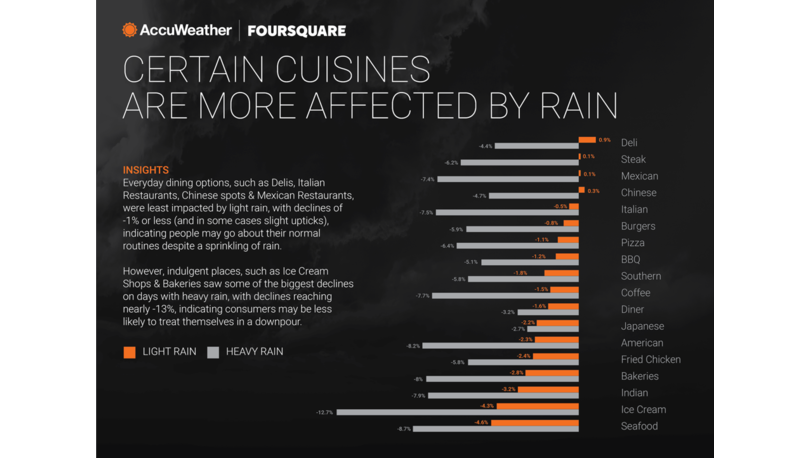Connect to AccuWeather APIs and deliver relevant customer experiences
mParticle users can connect to AccuWeather APIs to further enrich customer profiles with valuable weather data and provide even greater context.

To deliver outstanding customer experiences, today’s most innovative brands need to tailor their interactions so that they’re context-rich, personalized at the customer level and happening in real time. As digital-savvy consumers’ expectations have evolved, they’ve set an all-new benchmark that prioritizes relevance, in the moment, across channels and devices.
Few variables impact people as universally as weather conditions, which is why we’re excited to announce mParticle customers are now able to enrich customer profiles with localized weather data through AccuWeather’s Weather APIs.
Using AccuWeather’s APIs and mParticle allows brands to:
- Better predict customer journeys and weather’s impact on customer actions
- Improve marketing and sales forecasting based on real-time weather changes
- Target customers better and more accurately plan site-side and operational optimization based on weather conditions.
Weather data: Helping brands better predict customer journeys
Whether operating in a brick-and-mortar or digital capacity, consumer brands need to be mindful of how weather impacts people’s decision-making. This can manifest itself in a multitude of ways, including:
- The purchase of a cup of coffee — will it be hot, cold, or will the purchase happen at all?
- Will people shop at a physical location or be more inclined to visit an eCommerce destination?
- How are seasonal goods’ sales altered by fluctuations in weather patterns?
- Will heavy rain deter consumers from stopping at an ice cream parlor for a treat?
Today’s consumer brands can utilize weather data to better understand — and predict — their customers’ journeys. Armed with this additional context, brands have a greater opportunity of connecting with their customers through more meaningful interactions.
A closer look: How weather data can be used for marketing and sales forecasting
Beyond improving brands’ understanding of customers’ journeys, weather data can also be used to inform marketing and sales forecasting. In particular, companies in the Food and Beverage (F&B) industries can benefit from the inclusion of weather data in their forecasting and analysis of customer behavior.
By taking customers’ local weather into account, a leading beverage retailer’s business intelligence team was able to glean insights into how real-time weather variables impact a variety of customer purchases, leading to a 20 percent improvement in sales forecast accuracy. Because it leveraged weather data, the retailer was able to better predict when customers would be more likely to purchase iced beverages instead of hot drinks.
Marketers can use triggers activated by weather conditions to make communications more relevant, which results in higher conversion rates and ROI. For example, delivery services can use inclement weather forecasts to trigger email, push notifications or SMS messaging to encourage customers to order in. This “rainy day” messaging makes sense within customers’ context, increasing the likelihood that they will order in instead of braving the elements. Weather triggers can also be used to customize messaging and refine targeting for paid advertising programs.
Analyze weather data with additional datasets
Localized weather can have a big impact on store footfall, sales by product category and overall profitability. Analyzing weather data can help business owners determine how much product they should have on stock to meet demand and determine the number of employees likely needed to serve customers on a location-by-location basis.
For example, a forecast of light rain may seem insignificant, but as AccuWeather found through a partnership with Foursquare, bakeries and ice cream shops saw a sharp decline in foot traffic during rain, whereas everyday dining options were, more or less, unaffected. With this insight, bakery and ice cream retailers can use the rain forecast to make better operational decisions, such as lowering the quantity of stock ordered and revising staffing needs to ensure profitability on low footfall days.

How it works
AccuWeather’s Weather APIs capture customers’ current weather variables through the AccuWeather app, then send them to mParticle as event attributes. Weather variables available for collection include: Current weather conditions, hourly forecasted weather and the daily forecast. Weather event attributes are then associated with customer profiles that are enriched with real-time geolocation data to ensure accuracy.
Using AccuWeather’s Weather APIs and mParticle, brands can:
Trigger marketing campaigns related to specific weather conditions across email, push notifications, paid ads and more.
- Export events, with corresponding event attributes, to analytics or business intelligence endpoints/tools for deeper analysis.
- Understand how real-time weather conditions impact purchases made and the actions customers take.
- Determine how forecasted weather impacts purchases made or customer actions taken
- Leverage daily forecasts to plan messaging/site-side optimization, and target customers based on certain weather types via advertising or push notifications.
Currently, AccuWeather customers Amazon, LG, Motorola, Samsung, and Sony are benefiting from its Weather APIs. AccuWeather’s APIs handle 60 billion calls daily and are JSON-served with redundant global caching layers to ensure efficient and reliable service, worldwide.
For more details, please see AccuWeather’s API docs.
Interested in how mParticle makes it easier to build, maintain, and enrich persistent customer profiles? Learn more about our data quality features here.


